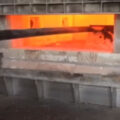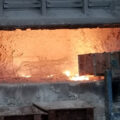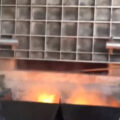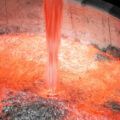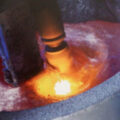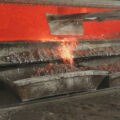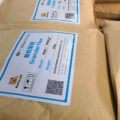6063 aluminum alloy is widely used in the construction of aluminum doors, windows and curtain walls, and is a common aluminum alloy model. In order to ensure that the doors, windows and curtain walls have high wind pressure resistance, assembly performance, corrosion resistance and decorative performance, the comprehensive performance requirements of aluminum alloy profiles are far higher than industrial profile standards. The refining process is the most important step in 6063 aluminum alloy melting, it will affect the product quality. The aluminum alloy melting need to control the following aspects.

Control Melting Temperature
Aluminum alloy smelting is one of the most important process links for producing high-quality casting rods. It needs to strictly control. If the process is not properly controlled, the casting rods will generate slag, pores, coarse grains, feather crystals and other casting defects.
It is better to control the melting temperature of 6063 aluminum alloy between 750-760 ℃. Too low temperature will increase the generation of slag inclusion, too high will increase the hydrogen absorption, oxidation. Studies have shown that the solubility of hydrogen in molten aluminum rises sharply above 760 ° C. There are many ways to absorb hydrogen, such as drying melting furnaces and smelting tools, to prevent the use of flux from moisture deterioration. However, the melting temperature is one of the most sensitive factors. Excessive melting temperature not only wastes energy and increases costs, but also is a direct cause of defects such as pores, coarse grains, and feather crystals.

Select Excellent Flux
Flux is an important auxiliary material used in aluminum alloy smelting. The main components of fluxes currently on the market are chlorides and fluorides. Among them, chlorides have strong water absorption and are prone to moisture. Therefore, the raw materials used in flux production must be dried. Remove moisture completely, seal the package, prevent damage during transportation and storage, and pay attention to the production date. If the storage date is too long, moisture absorption will also occur. In the melting of 6063 aluminum alloy, if the flux such as refining agent and covering agent absorbs moisture, which will cause the liquid aluminum to absorb hydrogen to varying degrees.
Choosing a good refining agent and a suitable refining process are also very important. At present, most of the refining of 6063 aluminum alloy uses powder refining. This refining method can make the refining agent fully contact with the aluminum liquid, which can maximize the refining agent efficacy.
Appropriate Refining Process
Although this feature is obvious, the refining process must also be noted, otherwise it will not have the desired effect. The nitrogen pressure used in powder refining should be small and can meet the requirement of blowing powder.
In addition, the pressure of the nitrogen gas is high, and the roll wave generated by the aluminum liquid is large, which increases the possibility of oxidized slag. If high-purity nitrogen is used in the refining, the refining pressure is large, the bubbles generated are large. The large bubbles have a large buoyancy in the aluminum liquid, the bubbles quickly rise, the residence time in the aluminum liquid is short. The hydrogen removal effect is not good and increases costs. Therefore, it should use less nitrogen, use more refining agents. The main point of the powder refining process is to use as little gas as possible and spray as much refining agent as possible into the molten aluminum.
Grain Refinement
Grain refinement is one of the most important processes in aluminum alloy casting, and it is also one of the most effective measures to solve casting defects. In alloy casting, all are non-equilibrium crystallization. Most of the impurity elements (including alloy elements, of course) are concentrated in the grain boundary. The smaller the grain, the larger the grain boundary area. The impurity element (or alloy element) is The higher the uniformity.
For the impurity elements, the high uniformity can reduce its harmful effects, and even turn the harmfulness of a small amount of impurity elements into beneficial. For the alloy elements, the uniformity is high, which can exert the greater alloying power of the alloy elements. So as to achieve the purpose of making full use of resources.
In the production of 6063 aluminum alloy, for abrasive materials, due to the need to produce a uniform sand surface through corrosion, the uniform distribution of alloying elements and impurity elements is particularly important. The finer the grain, the more uniform the distribution of alloying elements (impurity elements), and the more uniform the sand surface obtained after corrosion.



